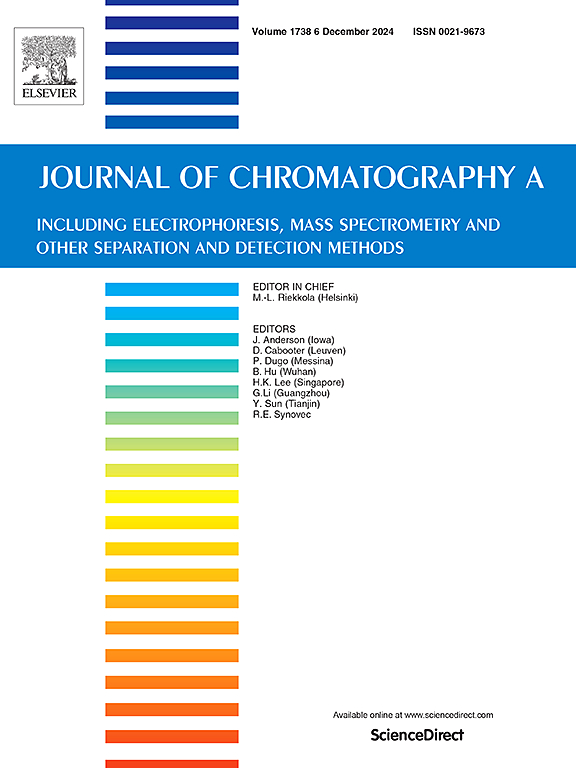优化在线 RPLC × SFC 的条件,以分析含有中性化合物的复杂样品:解决进样问题
IF 3.8
2区 化学
Q1 BIOCHEMICAL RESEARCH METHODS
引用次数: 0
摘要
反相液相色谱与超临界流体色谱(在线 RPLC × SFC)的在线结合是表征含有中性化合物的复杂样品的一种极具吸引力的技术,因为这两种技术具有很强的互补性,尤其是在超临界流体色谱(SFC)中使用极性固定相时。然而,由于 RPLC 中存在水有机溶剂,而这些溶剂在 SFC 中成为了进样溶剂,因此设置具有挑战性。本研究确定了许多关键实验参数,并发现它们对 RPLC × SFC 条件下的峰形有重大影响。这些参数包括反相液相色谱(RPLC)中的有机改性剂、SFC 中的助溶剂、SFC 中的梯度条件和色谱柱内径、阀门的配置,以及 SFC 中应最大化的进样量。在 RPLC 中使用乙腈(ACN),在 SFC 中使用 ACN 和甲醇(MeOH)的混合物(50/50,v/v),在 SFC 中使用最小初始成分为 5% 的 B,RPLC 和 SFC 的色谱柱内径分别为 1.0 mm 和 2.1 mm,以及在阀门后加入助溶剂的同时用纯 CO2 冲洗界面环路,这些条件都被认为完全适用于在线 RPLC × SFC。这些条件被成功应用于微藻生物油样品的在线 RPLC × SFC 分离。尽管进样条件不同寻常,但整个色谱图中的色谱峰是对称的,因此分离能力很强。本文章由计算机程序翻译,如有差异,请以英文原文为准。
Optimizing conditions in online RPLC × SFC for the analysis of complex samples containing neutral compounds: Solving injection issues
The online combination of reversed-phase liquid chromatography and supercritical fluid chromatography (online RPLC × SFC) is an attractive technique for the characterization of complex samples containing neutral compounds as the two techniques are highly complementary, especially with a polar stationary phase in supercritical fluid chromatography (SFC). However, the setup is challenging due to the presence of hydro-organic solvents in RPLC, which become injection solvent in SFC. In this study, numerous key experimental parameters were identified and found to have a major effect on peak shape under RPLC × SFC conditions. These parameters included the organic modifier in reversed-phase liquid chromatography (RPLC), the co-solvent in SFC, the gradient conditions and the column ID in SFC, the configuration of the valve and finally, the injection volume in SFC that should be maximized. Acetonitrile (ACN) in RPLC, a mixture of ACN and methanol (MeOH) (50/50, v/v) in SFC, a minimum initial composition of 5% B in SFC, column IDs of 1.0 mm and 2.1 mm in RPLC and SFC respectively and flushing the interface loops with pure CO2 while adding the co-solvent after the valve, are all conditions that have been identified as perfectly suitable for online RPLC × SFC. They were successfully applied to the online RPLC × SFC separations of microalgae bio-oil samples. Despite unusual injection conditions, the peaks were symmetrical over the entire chromatogram, leading to a high separation power.
求助全文
通过发布文献求助,成功后即可免费获取论文全文。
去求助
来源期刊

Journal of Chromatography A
化学-分析化学
CiteScore
7.90
自引率
14.60%
发文量
742
审稿时长
45 days
期刊介绍:
The Journal of Chromatography A provides a forum for the publication of original research and critical reviews on all aspects of fundamental and applied separation science. The scope of the journal includes chromatography and related techniques, electromigration techniques (e.g. electrophoresis, electrochromatography), hyphenated and other multi-dimensional techniques, sample preparation, and detection methods such as mass spectrometry. Contributions consist mainly of research papers dealing with the theory of separation methods, instrumental developments and analytical and preparative applications of general interest.
 求助内容:
求助内容: 应助结果提醒方式:
应助结果提醒方式:


